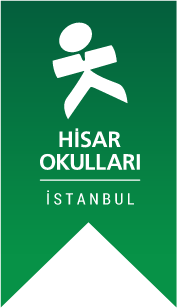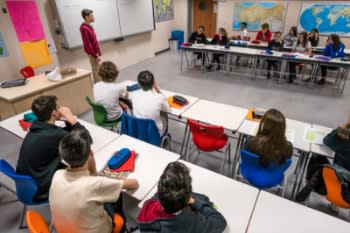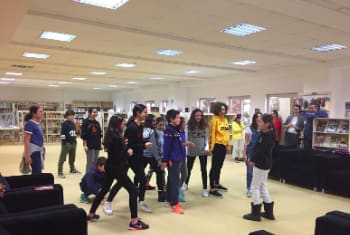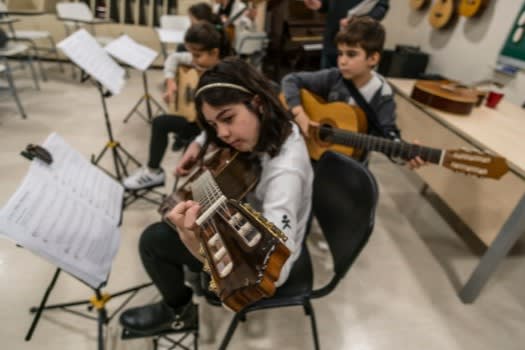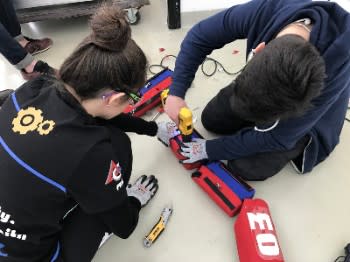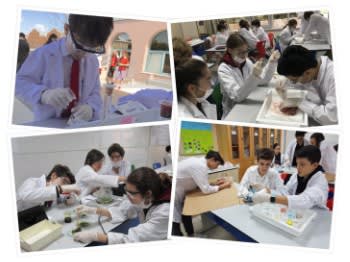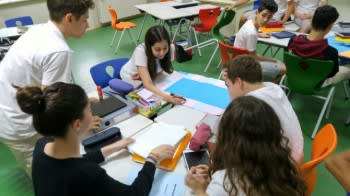Middle School Curriculum
At Hisar Middle School we aim to ensure that our students can discover their interests and skills, gain awareness to determine their life goals and have a strong character with the help of our innovative program, positive discipline concept, active learning approach and learning & education capabilities which encourage students to express themselves in the best possible manner.
Within the framework of our middle school program, our academic staff, who has expertise in each branch, follows the modern and rich curriculum of the Ministry of National Education, which sees learning as part of a whole process instead of only focusing on results.
Education of Religion and Ethics
The learning program for the Education of Religion and Ethics is carried out 2 lesson hours a week, following the general objectives of the national education and the specific aims of the course.
The purpose of the Education of Religion and Ethics is to contribute to raising generations who can understand, through reason and science, the connection between the universal humanitarian and moral principles and religious humanitarian and moral values.
Goals
In the Education of Religion and Ethics, inspired by Atatürk who said, “Each person needs a place to learn their religion, religious subjects, and faith. That place is the school,” we aim to raise individuals who:
- have a proper understanding of religion;
- are at peace with themselves and their surroundings;
- are broad-minded, considering differences as a cultural richness and using an inclusive language with a developed sense of coexistence;
- have realized their potential with a high sense of self-value, being stable and healthy in physical, mental, moral, and emotional terms.
Course Information
In line with the objectives of the course, we help our students to learn and/or acquire the desired knowledge, skills, attitudes, values, concepts while encouraging them to build a good character and develop high moral standards as well as the awareness about their social responsibility throughout the process of education and learning. To accomplish this, we follow the latest developments in education, adopt a student-centered approach, and utilize learning methods that foster understanding, research, questioning, and creativity.
During our course, we dominantly make use of individual and group activities, teacher & student discussions, as well as learning activities by practicing & thinking, thus encouraging our students to explain, interpret and assess the matters at hand.
While assessing and evaluating the course, we aim to determine the level of our students’ learning and understanding of the subjects, remedy their deficiencies by repeating subjects that are difficult to learn (feedback), and thus contribute to our efforts to develop future curricula. In our assessment and evaluation, we use a “process-oriented assessment” approach.
Assessment and Evaluation
Each term, we require our students to complete two written exams. The semester grade of a student is determined by averaging their exam grades, level of participation in course activities, and project grades.
English
Goals
At Hisar Middle School, we aim to improve our students’ English skills up to the level of native speakers. When Hisar Middle School students complete the 8th Grade, they are able to discuss any modern topic, write their opinions about anything and read and analyze complicated texts from modern fiction to modern non-fiction.
In our department, we also help our students to acquire 21st-century skills. In line with this goal and the mission of Hisar, our students learn to develop long-term working strategies with teamwork in classes, criticize their own work and behaviors and use technology efficiently in research and project design. Introduced to students in Grade 5 with short texts and presentations, these skills are gradually acquired by our students through writing research projects on current issues and taking part in class debates in Grade 8.
Course Information
For the Middle School English program, we follow the Common Core Curriculum applied in the United States of America. The common core curriculum focuses on understanding the relations among different branches more closely, thus ensuring that courses are designed to offer specific and pragmatic skills. Such a different approach to education supports creative methods and, knowing the strengths and weaknesses of students, offers opportunities that will lead all students to success.
The units covered in lessons are based on the principle of Understanding by Design (UbD). Understanding by Design is a framework to increase the success level of students. Our teachers cooperate to design courses in line with basic and interesting questions. Our students gain the skills of grammar, speaking, writing, reading and listening to deeply analyze complicated theories, form their own arguments and express themselves according to high academic standards. Our unit subjects are reviewed and updated by our department each year.
Assessment and Evaluation
Final assessments include creative writing, drama performances, presentations, essays, debates, research tasks as well as exams on reading and grammar. These assessments are a part of our daily curriculum. During the process of learning, we emphasize the process that will bring success to students. Each day, students obtain feedback related to their grade assessments while developing their skills during lessons. Each task and exam is assessed according to a rubric once it is explained to the students how to use it correctly. It is one of the priorities of the English department to teach self-assessment to students.
Activities and Trips
Information Technologies
Technology functions as a natural part of Hisar School’s education process. The aim of our Information Technologies Program is to help our students to become efficient and productive individuals with the necessary skills in digital technologies and to gain other relevant skills through our curricula, approaches and activities necessitated by the current digital age. Our curriculum mainly supports the following areas, and we adopt an interdisciplinary approach.
- Creativity and Renovation
- Communication and Collaboration
- Research and Critical Thinking
- Problem-Solving and Decision-Making
- Algorithmic Thinking
- Digital Citizenship and Awareness
- Design and Production
Having a dynamic perspective, our Computer Education department regularly makes the necessary updates and changes in its content and physical equipment. In addition to the Information Technologies classes, we also offer elective courses, clubs, projects, and after-school activities, thus providing our students with opportunities to fulfill their potentials in different areas of technology. These areas can be listed as follows:
- Programming
- Robotics
- 3D Design
- Electronics
- Graphic Design
- Multimedia
Within the framework of these areas, our students use the ideaLab workspace which offers them a flexible learning environment designed for them to successfully carry out projects and studies, be inspired, be focused and reach their goals via peer learning. This space has turned into a living, transformative and productive learning environment in which our students carry out a wide range of projects, activities and studies. Moreover, our school has the necessary learning environments with computer labs and multimedia labs offered in all three stages of education.
For the purpose of encouraging our students to take an active role in their learning process while using those spaces and carrying out their activities, we may summarize our perspective with the following motto: “Make, Fail, Learn and Repeat.”
At Hisar School, we make technology a natural part of the learning environment by using 1:1 iPad program in Middle School and adopting a BYOD (Bring Your Own Device) policy in High School. To support this process, we offer technological training not only to our students but to our teachers, as well. Within the framework of Education Technologies, we provide the necessary training and activities to create and accommodate a learning community at our schools.
Information Strategies Policy
At Hisar School, we believe that when used efficiently, technology provides numerous and invaluable opportunities and experiences for the users (students, teachers and staff). When technology is structured and used to support education programs, it will help students to gain 21st-century skills… Read more
Course Information
Information Technologies and Software
The objectives of our Information Technologies and Software course for Grades 5-8 are determined individually for each level, based on the readiness of our students. Our IT and Software classes are held in the computer lab at our Middle School and taught for 2 hours per week in all grades across the middle school level. We primarily aim to raise the awareness of our students on the following topics that are included in our curriculum for the academic year: “Digital Citizenship, Digital Literacy and Internet Safety”. We also give our students the chance to improve their interests and skills in various areas of information technology, which will optimize their readiness for the requirements of the 21st century. As such, we prioritize interdisciplinary studies, projects as well as national and international contests, performed and held throughout the year, in the areas of “Information and Communication Technologies”, “Communication, Research and Collaboration”, “Ethics and Safety”, “Digital Product Design”, and “Problem-Solving and Algorithm Development”.
Technovation
Technovation is a non-profit international organization based in San Francisco, California, which aims to help female middle school and high school students around the world to improve their skills in the areas of entrepreneurship and software, and it has been joined by over 10,000 female students from nearly 78 countries since 2010. Our Technovation club’s objective is to encourage our female students to think of a problem in their surroundings and approach it from multiple aspects, help them develop a mobile application that works towards the solution of that problem and also to have them assess their application in terms of entrepreneurship. In this process, which takes an academic year to be completed, our students gain experience in areas such as entrepreneurship, problem-solving, business plan preparation, programming and interface design, and their applications are evaluated by an international platform at the end of the year.
Programming & Robotics Projects
These club activities support our students who want to be introduced to robotics, gain experience in this field, take part in national and international innovative projects for robotics and programming and have a desire to develop their own projects. Our students get the chance to improve themselves in the fields of algorithm development, numeric calculations, electronic devices and robotics studies.
“Maker Lab” Studies
This club welcomes students who are interested in the area of “Problem-Solving and Programming” which is one of the basic learning outcomes of Information Technologies.
The club is oriented towards our students in Grades 5 and 6 and helps them improve their creative and innovative skills. It aims to inspire our students to develop creative projects in the areas of programming, electronics, 3D modeling and design throughout their participation in the club.
Mathematics
“Pure mathematics is, in its way, the poetry of logical ideas.” Albert Einstein
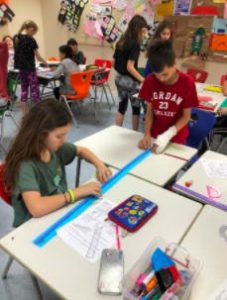 GoalsAt Hisar School, the course of Math does not promote memorization but focuses on developing the skills of analytical thinking, decision making and problem solving while keeping individual differences in mind.
GoalsAt Hisar School, the course of Math does not promote memorization but focuses on developing the skills of analytical thinking, decision making and problem solving while keeping individual differences in mind.
The goals of the course include discovering and developing the individual potentials of students, helping them take a positive attitude towards math, encouraging them to analyze the nature of math, improving their skills of processing and problem solving, increasing their sense of responsibility, as well as helping them to see the relationship between math, the daily life and other disciplines, and encouraging them to express their own opinions while respecting others’ opinions, as well.
Course Information
Hisar applies its own curriculum, which is based on the curriculum of the Ministry of National Education and enriched in line with the UbD plan. Upon determining the students’ level of readiness, we aim to enable them to discover all the concepts included in the curriculum on their own by following an investigative approach. We expect each student to understand that there is a mathematical truth behind each concept or method mentioned in the course. While covering the math lessons, we also pay attention to using English and provide the relevant terminology in each unit.
When introducing a topic, we carry out preliminary activities to increase students’ awareness about the relevant subject. While selecting those activities, we try to choose examples from our daily lives which to make the subject more interesting and memorable for students. We support critical thinking with leading questions.
We prepare and carry out activities for students to practice what they learn and to develop a different perspective on concepts while covering the lessons. During these differentiated class activities, we check the work of each student individually and give them personal feedback. While conducting differentiated class activities, we also make use of peer learning.
In math lessons, we use different activities for students with different learning speeds. With the help of advanced math activities in and out of class, we provide opportunities for students who want to research topics related to math, increase their knowledge of math and improve themselves in this field of study.
Before the exams, we aim to increase the awareness of students by sharing an exam outcome table with them. Exam self-assessments applied after exams provide an opportunity for students to assess their exam outcomes and improve their skills. To address the needs of each student individually, our teachers give additional tasks after exam assessments. These are personal assignments that focus on the subjects that a student did not understand quite well.
Assessment and Evaluation
We frequently use quizzes and exit cards as part of our process-oriented assessment. Exit cards measure the content of the lesson while quizzes are more comprehensive. Applied as an assessment and evaluation tool, tests are designed to improve the students’ skills related with the subject at hand.
Transfer activities at the end of units are crucial for establishing the relationship between the topics covered in that unit and daily life. Our transfer activities, which are based on the UbD approach, are designed to answer the following question: “Where can I use this in my daily life?” Our activities support critical thinking since they consist of open questions which both cover the content of the subject and also lead the student to arrive at their own conclusions.
As necessitated by our curriculum, many units covered in previous years are repeated in future years. However, with our refreshment works, students’ knowledge from previous years is refreshed and reinforced.
“Closing the Gap Booklets” provided at the end of units consist of questions about the covered unit. By directing students to solve these booklets, we aim to repeat the covered unit and close the relevant gaps.
We give and follow assignments regularly in order to reinforce the students’ knowledge and encourage them to research by themselves and gain new knowledge during the learning process.
We support our students with the extra study times we schedule on a weekly basis so that they can repeat the subjects. In addition to those studies, we also provide extra study time for math to meet the individual needs of students.
Each environment that supports teamwork and active learning is a learning environment. We also make efficient use of technology to support learning environments. We have made the necessary adjustments in our curriculum for distance learning and use methods to facilitate the learning process of our students when they are not present in school. We have enriched the process with applications used for learning.
We frequently use “Google Classroom” to communicate with students for math lessons. Here, we have all the announcements, assignments, answer keys, books and other resources relating to the class of the relevant student.
Oral points given to students at certain intervals are determined each term based on their work, results of mid-term evaluation, assignment results and class participation. Within the framework of process-oriented assessment, these oral points may change positively as a result of the student’s diligence and effort.
Activites
Modern Languages
As the Department of Modern Languages, we offer our students a language learning environment where they can improve their language skills, increase their cultural awareness and become effective individuals in the global world in our French, German and Spanish courses. We plan our second foreign language program, which starts in the 5th grade and continues until the end of the 8th grade, based on the Common European Framework of Reference for Languages prepared by the Council of Europe. In this context, we aim to raise our students as world citizens who can adapt to the modern world, have knowledge about the cultural and social life of the target language, master 21st century skills, think critically, and acquire communicative competence in a foreign language.
All of our students take the internationally recognized and internationally recognized DELE – DELF – FIT language proficiency exams at the end of the 7th grade. At the end of 8th grade, they complete secondary school with A1 plus and some of the A2 outcomes.
Department Goals: The main objectives of the Department of Modern Languages are to enable our students to develop the four basic language skills (listening, speaking, reading, writing) and to become competent individuals in communication. In addition, we encourage them to gain cultural knowledge and to become individuals who respect different cultures in the process of language learning. During secondary school, we aim to provide students with the ability to express themselves confidently in the languages they learn and to use resources other than their mother tongue effectively.
Teaching Style: Our lessons are taught with a student-centered and interactive approach. As active participants in the language learning process, students reinforce their learning through various activities and projects. Group work, language games, role-playing activities and digital resources are an important part of our teaching. We enable our students to improve their language skills with technology-supported educational materials. At the same time, we offer a personalized learning experience by providing course materials suitable for students’ individual learning pace.
Assessment and Evaluation: Our assessment and evaluation process aims to evaluate students’ language skills in a multifaceted way. Not only exams, but also projects, performance assignments and class participation are included in the assessment process. We support our students in their learning journey by monitoring their language development through continuous feedback mechanisms. In addition to the written and oral exams at the end of each semester, we monitor the progress of our students throughout the year.
Music
Branch Courses
At our school, from the 4th Grade onwards, the general Music lessons are replaced by the instrumental branch lessons to be selected by our students in line with their talents and wishes within the limits of the music curriculum of the Ministry of National Education.
The main idea behind this system is to teach our students the instruments of their selection. However, generally, a certain trial period has to pass before being certain about the appropriateness of these choices.
As part of this system, the selection of the best-suited instrument for a student is shaped by our teachers’ observations during music lessons in the 3rd Grade.
Starting from Grade 4, our students select a branch among the piano, violin, classical guitar, flute, trumpet, saxophone, clarinet, vocals, and percussion, which they continue to learn until the end of Grade 8; they have the chance to enhance their musical instrument education with selective courses in High School.
After the 5th Grade, our Orchestra Clubs, which carry out activities at the Middle School and High School levels, provide an opportunity for all students to make music collectively.
The purpose of branches is to help our students learn how to play an instrument well before graduation and take part in school orchestras during their time in school.
Physical Education
The Physical Education program of Hisar Schools follows the curriculum of the Ministry of National Education, keeping in mind the individual needs and differences of the students. Different and original branches of sports are added to the program for our students to experience.
Goals
By taking their individual differences into account, we aim to help our students to gain and maintain a lifelong habit of doing sports on a regular basis upon choosing a branch that best suits them. Our main goal is to provide our students with the basic skills for the sports branch in the units determined according to their grade levels.
The Program
The Physical Education course is scheduled as 2 hours a week (block scheduling for 80 minutes) for the middle school level (Grades 5, 6, 7, and 8).
Due to physical differences seen in middle school students, we organize separate classes for girls and boys for them to take part in applied lessons. The classes are taught within the same hours at 4 different physical areas for 4 different branches on a rotating basis. Students exercise for 4 different branches every 8 weeks.
Throughout the year, we hold school tournaments among classes across the same grade level for 4 weeks on predetermined dates (Floorball, Korfball, Handball, Kin-Ball).
Activities and Trips
Tournaments
We organize Handball, Floorball, Futsal, Streetball, Volleyball, and Korfball tournaments for our Middle School students.
Hisar School Sports and Friendship Festival
Each year, in the last week of the first term, we hold the “Hisar School Sports and Friendship Festival” (7th festival was held this year) which lasts for 3 days with the participation 12-14 private and state schools. During these 3 days, 700-800 students take part in the activities. We also include our Students’ Unions into this process and cooperate with them as necessary for this event.
School Teams
After-school training sessions for the school teams are carried out 2 days a week, between 15:40-16:30. The school teams represent Hisar Schools in competitions held in the district and city, as well as in the special games. School teams are registered according to the age limit for the licensing of the year.
General Categories are determined according to grade levels for related age groups:
- Juniors: Grades 5 and 6
- Juniors: Grades 7 and 8
- Youth: Preparatory – Grade 12
We ensure the participation of our school teams in the special and official sports competitions starting from October. Our school teams participate in 130-140 off-campus competitions in a year. In addition to these competitions, we also organize other events for our Primary School, Middle School and High School students, such as water games, Datchball, Head Soccer, Fun Athleticism, Tug-of-War, Dodgeball, and Student-Teacher Tournaments, in different periods throughout the year.
|
Primary School Teams |
Middle School Teams |
High School Teams |
|
1-Littles Girl Basketball |
1-Minors Boy Futsal |
1-Seniors Boy Basketball A-B |
|
2-Littles Boy Basketball |
2-Juniors Boy Futsal |
2-Seniors Girl Handball |
|
3-Littles Boy Futsal |
3-Minors Gir Volleyball |
3-Seniors Boy Football |
|
4-Littles Girl-Boy Table Tennis |
4-Juniors Girl Volleyball |
4-Seniors Girl Volleyball |
|
5-Littles Girl-Boy Chess |
5-Minors Girl Handball |
5-Seniors Girl-Boy Chess |
|
6-Littles Girl Gymnastics |
6-Minors Boy Handball |
|
|
7-Juniors Boy Handball |
||
|
8-Minors Boy Basketball |
||
|
9-Juniors Boy Basketball |
||
|
10-Minors/Juniors Girl-Boy Table Tennis |
||
|
11-Minors/Juniors Girl-Boy Chess |
||
|
12-Minors Girl Gymnastics |
||
|
13-Dance Team |
Science
“Science is a way of thinking much more than it is a body of knowledge”- Carl Sagan
The Middle School Science course of Hisar Schools follows a learning approach focused on research and questioning. We want the students of the Science department to:
- understand and properly utilize fundamental science concepts, principles, laws and theories;
- benefit from scientific process skills while solving problems and making decisions;
- understand interactions among science, technology, society and environment;
- improve scientific and technical psychomotor skills;
- gain scientific perspectives and values.
Goals
Our learning program, covering different areas with an eye to the 21st-century learner profile, includes activities that will help students to:
- gain Science literacy, research, investigation, and critical thinking skills;
- understand the dynamic interactions among science, technology, society and environment;
- acquire the necessary knowledge, skills and habits for leading a healthy life;
- benefit from scientific process skills while solving problems and making decisions;
- be lifelong learners;
- be more interested in Science;
- create their own scientific products by adopting the attitudes and behaviors of scientists.
Course Information
At our department, we emphasize that science is a way of thinking and aim to make our students scientifically literate. As such, the course gives weight to activities that will encourage students to internalize the ability to research and question scientific information and use this skill throughout their lives. We carry out scientific research and projects so that our students can acquire the skill of discovering valid and reliable resources. Thus, we make an effort for our students to gain the skills of analyzing, interpreting, and finding solutions to real-life problems, which they are expected to use not only during the course of their studies but also later in their adult lives. Designed with the approach of Understanding by Design (UbD), our syllabus offers experiences that will ensure all the information and skills learned in Science classes can be applied in real life. We also provide the opportunity for teamwork in our lab to underline the importance of cooperative learning.
While designing and applying syllabuses intended for permanent learning (UbD), we make use of innovative learning methods such as STEM and Engineering Design. Thus, we create learning environments in which students will actively learn by engaging with a context.
Middle School Science classes are taught in two languages, English and Turkish. We aim to teach scientific concepts in English and encourage our students to use certain fundamental scientific phrases in English. For the purpose of testing our students’ knowledge and skills in Science in English with comparison to the international scale, we make them take the ISA Scientific Literacy test and then we plan the content and level of our course based on their test results. We also provide our students with bilingual textbooks of Science Units, which are designed by the branch teachers to include the enriched content for each unit covered throughout the year. We ensure that students can take part not only in national science competitions but also in international competitions, which gives them the opportunity to write and present their research and experiment reports in English.
In the Science class, we also implement differentiated learning activities for our students. Practices through which students are monitored individually and provided with personal feedback include Tailoring Science activities that are designed for students with different learning speeds, lab activities with rubrics at different levels, mini-projects, and Science Reinforcement Activities (SRA) which are created specifically for each student according to their exam grades. Thus, we offer various opportunities for students to discover their potential, as specified in our school’s mission.
We plan interdisciplinary activities with the courses of Information Technologies, Math, and Visual Arts, thus encouraging students to use their knowledge and skills in various areas. Students also have the chance to participate in a wide range of competitions with their projects and observe different learning environments and products.
We benefit from many iPad applications in order to diversify the learning materials of Science lessons. Moreover, we make efficient use of Google Classroom to follow announcements and process-oriented activities. We provide the students who are interested in the subject with the technological devices they need to complete their projects and support their efforts.
In Hisar Middle School, there are two Science labs that were renovated in the academic year of 2018-2019. Throughout an academic year, we organize nearly 250 experiments and activities in our labs which are designed as flexible learning environments by our branch teachers to accommodate the needs of a 21st-century learner. Our learning environment is enriched by various visuals to increase our students’ interest in science as well as their questioning skills. Our labs and constantly updated lab materials are also available for use of the students who carry out Science projects after school hours.
Assessment and Evaluation
The assessment policy of Hisar Schools focuses on process-oriented assessment in addition to written exams. Therefore, we apply, among others, mini-tests, retake tests, additional studies, optional Science projects for the term, Science Reinforcement Activities, daily and weekly homework, lab activities, pre/post-tests, exam outcome forms, and exam self-assessment forms to remind the students that they own their learning process.
Activities and Trips
Social Sciences
Goals
With our courses offered in the Department, we want to help our students to become individuals who:
- are aware of the developments in the 21st century and have knowledge about the past periods resulting in the current change;
- question every type of information given to them, regardless of the source of that information, are able to develop justifiable opinions and advocate for their opinions with democratic ways and methods, are aware of their democratic citizenship rights and responsibilities;
- know the democratic gains of the Republic and the efforts of its founders, most importantly, the efforts of M. Kemal Atatürk;
- have respect for different cultures, beliefs, lifestyles, and views, have strong communication skills, are able to empathize with others, are against discrimination;
- are aware of the environmental and social phenomena/issues in their close and distant surroundings and are able to find peaceful solutions to those issues in line with human rights and universal values.
Course Information
In the 21st century, when mass media develop with a dizzying speed and access to information becomes increasingly easier, we apply a constructive and structured education model in our lessons which are designed in consideration of the fact that we are surrounded by scientific and unscientific information, normative and informative propositions, and personal opinions & views and facts. Generally, the fundamental and basic concepts of the course as well as the knowledge of facts and events are taught through the analysis of texts and visuals (pictures, caricatures, etc.) in the unit booklets designed by our department. We make comparative readings on texts, thus encouraging students to find theses and antitheses. We hold discussions between groups of opposing views. Students carry out mind mapping activities to demonstrate causal relations between events/situations. Reading and writing activities are completed to enhance students’ history literacy in line with their relevant level. For collective learning, we organize activities in small and large groups.
Assessment and Evaluation
In evaluation, we make use of a process-oriented assessment method that focuses on what and how students learn, rather than their results. For the purpose of collecting data on the readiness level of our students and their development in time and adjusting learning processes in line with needs found as a result of this data, we require assignments, tests, and quizzes and hold in-class discussions as well as reading and writing activities.
Activities and Trips
Turkish
“Turkish language is a wide sea holding various shades of colors within its depth, extent, unlimited power and beauty.” Yaşar Kemal
Our Education Program for Turkish helps our students to acquire language skills and mental skills for verbal and written communication which they can use throughout their lives. These skills are taught through exercises in the areas of reading, writing, speaking and listening. While constructing those skills, we aim towards a whole package of knowledge, skills, and values which will assist students in developing themselves personally and socially, communicating effectively, and acquiring the habit of reading & writing willingly with a passion for Turkish language.
Goals
The goal of the Turkish Education Program is to contribute to the cultivation of individuals who:
- can use Turkish correctly and effectively;
- can express themselves and communicate and cooperate with others with a high capacity for entrepreneurship and problem-solving;
- know their rights and responsibilities, have a high level of self-confidence, are cooperative with others, and express their views and opinions in written and verbal communication with valid justification and proof;
-
can comprehend, criticize and combine what they read while also enjoying the experience of reading and learning;
-
can utilize information technologies safely with advanced capabilities of learning, creating and sharing information.
We want our students to be citizens of the world by respecting different cultures through the distinguished literary works of the Turkish literature and the world literature, thus turning their learning into actual skills. Therefore, in our education program, we facilitate the development of their mental capacity, intellectual knowledge and world of opinions with the help of visual imagery as well as intellectual texts and research relevant to our daily lives.
Our Methods of Teaching
Each year, our students read a selection from the distinguished works of the Turkish literature and the world literature in consideration of their level of readiness. These readings are completed through guidance (reading as accompanied with a teacher in class, also involving activities) and the student’s reading performance (students read by themselves and apply what they learn).
Learning outcomes of grammar, reading-comprehension, speaking and writing are acquired with the help of a holistic approach by making associations with texts in a helical structure. This process is carried out with “BIRIKIM” (meaning accumulation in English) booklets which are designed and constantly revised by our department teachers in compliance with the curriculum of the Ministry of National Education. Our course is structured to serve to the differentiated education model with methods such as individual studies and teamwork, written and oral exposition, repetition of subjects and presentations via forms and applications developed electronically, and use of reading techniques and methods.
Our students can proactively follow relevant information such as studies, assignments, activities and course announcements by using an iPad via Google Classroom throughout the year and prepare their research, presentations, assignments and projects via an iPad; in cases of distance learning and hybrid learning, students can again attend to their classes by using Google Meet.
Types of Assessment
We take into consideration all the work, effort and preparation of our students during the evaluation process. In addition to a written exam required each term for assessing and evaluating the success of our students, we also conduct a process evaluation with online activities, tests and exams in order to observe their development during the process. For process evaluation, starting from the beginning of the term, we follow the texts in Birikim booklets and the guided reading processes and evaluate grammar skills of the students. Our purpose is to observe the development of students with their work accomplished during this whole process and to facilitate and grade their last work which will be shaped with the chance given to them to adjust/improve it in their written exposition activities.
Course Information
For the Turkish Course, our students read a selection from the distinguished works of the Turkish literature and the world literature in consideration of their level of readiness each year. These readings are completed through guidance (reading as accompanied with a teacher in class, also involving activities) and the student’s reading performance (students read by themselves and apply what they learn).
Learning outcomes of grammar, reading-comprehension, speaking and writing are acquired with the help of a holistic approach by making associations with texts in a helical structure. This process is carried out with “Birikim” (meaning accumulation in English) booklets which are designed and constantly revised by our department teachers in compliance with the curriculum of the Ministry of National Education. Our course is designed to diversify education by using methods such as teamwork, drama, written and oral exposition, presentation as well as reading techniques and methods.
Our students can proactively follow relevant information such as studies, assignments, activities and course announcements by using an iPad via Google Classroom throughout the year and prepare their research, presentations, assignments and projects via an iPad.
Assessment and Evaluation
We take into consideration all the work, effort and preparation of our students during the evaluation process. In addition to a written exam required each term for assessing and evaluating the success of our students, we also conduct process evaluation activities in order to observe their development during the process. The results of process evaluation are determined by following the students’ progress regarding texts in Birikim booklets and the guided reading processes, starting from the beginning of the term, and by evaluating their grammar skills. Our purpose in assessment and evaluation is to observe the development of students with their work accomplished during this whole process and grade their last work which will be shaped with the chance given to them to adjust/improve it in their written exposition activities.
Activities and Trips
Visual Arts
The Department of Visual Arts aims to encourage every student to create by giving them the opportunity to implement the art practices they learn during classes.
The Department does the following:
- It carries out the necessary efforts to provide students with multiple environments that will help them to discover their potential and express themselves in artistic terms.
- It prioritizes building a sense of social responsibility in students. As such, it supports projects on “Social Responsibility through Arts” and encourages students to develop projects on this subject.
- It designs lesson activities that will help students to practice what they learn while also giving the theoretical knowledge necessary to be a good audience and reader of arts.
- It encourages students to share their individual development and intellectual capital with their friends. Therefore, any willing student can participate in the activities of the “Hisar Series of Mixed Exhibition”.
- It encourages all students to take part in school projects, out-of-school projects and competitions so that they can know and express themselves through arts.
- The department considers it crucial for students and teachers to meet other schools in art venues and to share their own work; therefore, each year, it participates in extramural activities as well as national and international projects.
- It is important for the department to carry out its activities consistently in all grades, from pre-school to the last grade of High School, with the participation of all the teachers.
- The students are given the opportunity to visit international spaces in which they can research the topics they wondered and selected for themselves, to apply their experience in daily life, and to create projects based on their individual interests and skills.
- It supports each student in consideration of his/her individual characteristics in order to raise individuals who can connect with the past, make use of the culture and artworks of the past in their current works, benefit from interdisciplinary interactions in their art spaces and environments, turn their thoughts into unique artworks, understand the necessity of art and believe that they can use their creativity in any area.
Course Information
As part of Visual Arts lessons, Hisar Middle School provides:
- 1 hour of Visual Arts class per week in Grades 5, 6, 7 and 8
- 2 hours of Technology and Design class per week in Grades 7 and 8
- Color Painting Techniques Club and Ceramics Club classes designed for different levels.
The course content is as follows:
Visual Arts
The education program for the Visual Arts course is designed to accommodate various aspects consisting of visual communication and forming, cultural legacy, art criticism, and esthetics learning area as well as other skills which increase in parallel to the grade. Naturally, the program supports vertical planning and is oriented towards permanent learning.
The program focuses on internalizing what is learned during the program and interpreting artworks more knowledgeably, and sharing personal values and ideas while praising arts; analyzing and assessing how artists use figures, materials, and symbols in their works; researching, analyzing, and discovering the creative process which leads to the creation of an artwork, designing with the use of traditional and modern art materials in line with art equipment and design principles, developing a visual arts language, researching the significance and value of arts; and making simultaneous use of different techniques while creating visual artwork.
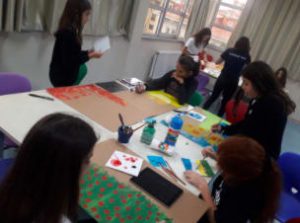 Perception The basic skills intended for the students to gain are:
Perception The basic skills intended for the students to gain are:
- Analysis
- Use of Information Technologies
- Evaluation
- Multiple-Perspective Thinking
- Critical Thinking
- Hand-Eye-Brain Coordination
- Artistic Sensitivity
- Visual Literacy
- Cultural Legacy
- Ethics of Art
- Self-Awareness
- Design & Media Literacy
- Observation
- Use of Materials
- Synthesis
- Creative Thinking
Technology and Design
 The basic skills intended for the students to gain are:Technology and Design course aims to equip individuals with literacy in this area and help them become life-long learners who can apply what they have learned in real-life, make use of technology and design processes for the benefit of both themselves and their community, and understand, interpret, manage and assess the process of technology and design. Within that framework, we aim for the students who complete the course of Technology and Design to be able to observe and interpret the objects, events and facts in their surroundings from an analytical perspective, define problems and offer innovative, unique and alternative solutions to these problems, assess the validity of their solutions and decide which one is best suited for the matter at hand. In this course, we also aim to teach students that technology and design have both positive and negative effects on daily life, and help them become individuals who have gained awareness out ethical rules in practices of technology and design and know that their technology and design products must have a minimum negative impact.
The basic skills intended for the students to gain are:Technology and Design course aims to equip individuals with literacy in this area and help them become life-long learners who can apply what they have learned in real-life, make use of technology and design processes for the benefit of both themselves and their community, and understand, interpret, manage and assess the process of technology and design. Within that framework, we aim for the students who complete the course of Technology and Design to be able to observe and interpret the objects, events and facts in their surroundings from an analytical perspective, define problems and offer innovative, unique and alternative solutions to these problems, assess the validity of their solutions and decide which one is best suited for the matter at hand. In this course, we also aim to teach students that technology and design have both positive and negative effects on daily life, and help them become individuals who have gained awareness out ethical rules in practices of technology and design and know that their technology and design products must have a minimum negative impact.
- Self-confidence
- Analysis
- Observation
- Environmental sensitivity
- Responsibility
- Analytical thinking
- Discovery of innovative and unique solutions
- Ability to cooperate
